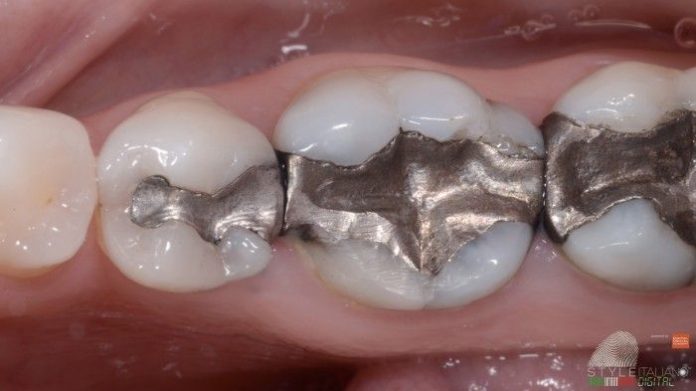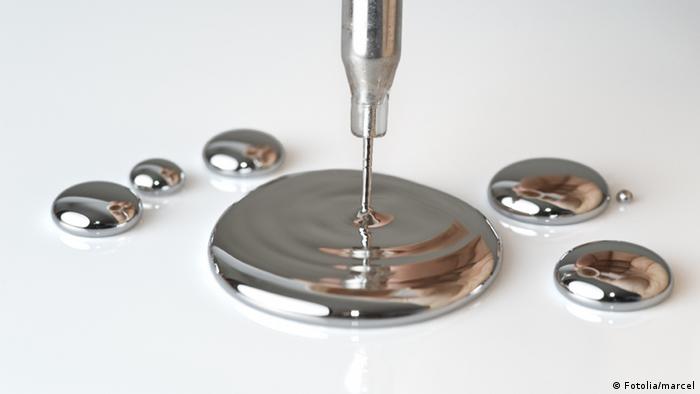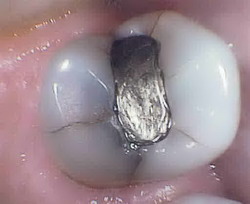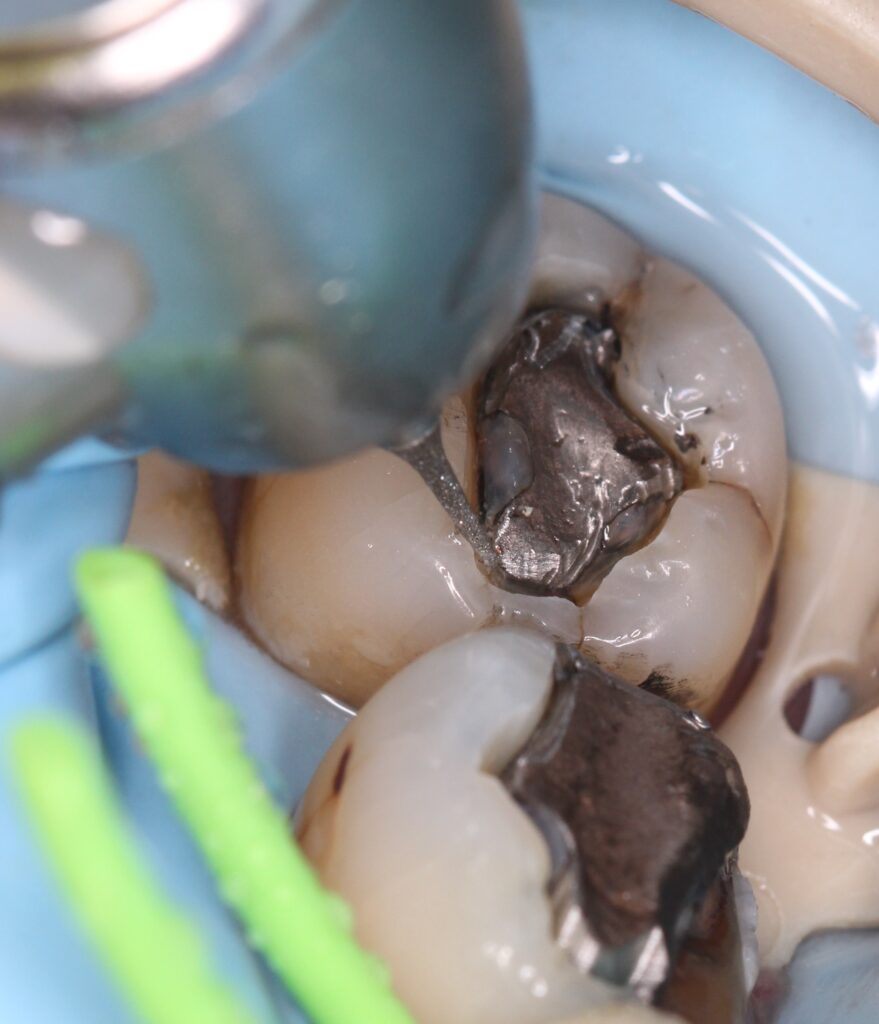
Amalgam just means a mixture or a blend; in dentistry it refers to a blend of different metals that when combined make a hard wearing material that has been used to fill cavities (holes) in teeth, some say as far back as 659AD in China. Over the years the mixes developed with different metals being involved, apparently lead was even used in the early 18th century

The use of mercury in amalgam fillings dates to about 1800 and the story of how it first came to the United States is rather interesting. English uncle and nephew team of Moses and Edward Crawcour sailed to the United States around 1833 . The story goes that they made a lot of money filling teeth with ‘quick silver’ amalgams in New York and at the same time enraged the local dentist population. One of the disgruntled local dentists had a filling from Edward and Moses and then immediately had it removed just to test its composition . When they found mercury in the filling they set out to get them arrested. By the time the arrest warrants were issued Moses and Edward were already on their way back to to the UK.
Modern amalgam fillings contain a mix of about 50% liquid mercury with the remainder being a powdered mix of metals containing silver, tin, copper and some other trace elements. The mercury is used because it binds to the other metals and it helps to form a very strong, long lasting and relatively cheap filling material, the main reasons why it is still being used today.
So far so good, then so what’s the issue?

Aside from their appearance, the main issue that most people raise when it comes to amalgam fillings is the fact that they contain mercury. Whist it is undeniably true that mercury is toxic to humans, it is equally true to say that mercury combined in an amalgam is not toxic. Think of it like common salt, made of Sodium and Chlorine. Individually you would not want to eat either of these elements, but combined we’re happy to put them on our chips. The real issue is that even when combined in an amalgam, mercury can release small amounts of mercury vapour – this has been generally accepted and is backed by research in both the UK and America.
The controversy
So we have the smoking gun! Small amounts of mercury vapour can be released from amalgam fillings, case closed. Well, the research would seem to suggest that the level of mercury released from amalgam fillings is not significant enough to cause harm to the general population. This has led to the majority of world governments to continue to sanction the use of amalgam filling. Notable exceptions include Ireland, Finland and Slovakia, Norway and Sweden who have either fully banned or are phasing out the use of them imminently.
The Minamata Convention on Mercury

In 2013 UK adopted signed and agreed to the points raised at this convention. The focus was on reducing the amount of mercury in the environment across all the industries that use it . In a dental sense the main release of mercury into the environment is from the placing and removal of amalgam fillings and at the end of life the release of mercury vapour through cremation. As a result the UK agreed to no longer use amalgam fillings in pregnant women and children. Some would say this is an overdue move given the very limited amount of clinical data on the long term health effects of mercury exposure in pregnant women, their developing fetuses and young children.
So, what does The Natural Smile think about amalgam fillings?
The simple answer is that we think there are far better materials out there to use than amalgam, and for that reason we have never and will never place one. Some key reasons are

- It’s properties as a filling leave a lot to be desired. Whilst it is hard wearing, metals tend to contract and expand at a different rate to your teeth, so if you have a hot drink the metal will expand quicker than the surrounding tooth, over time this can lead to tiny fractures in your tooth.
- Amalgam is not bonded to the tooth, this means that there will be microscopic gaps that over time can let bacteria in and under the filling causing decay which you cannot see.
- Why use a material that has even a tiny potential to cause harm when there are other, far superior materials available.
- The environmental consequences of mercury release particularly bioaccumulation in humans and wildlife is significant concern world wide.
Why use a material that has even a tiny potential to cause harm when there are other, far superior materials available?
So the end of the story – not quite.
You may have come to the conclusion after reading this far that you want to have your amalgam fillings removed and replaced with modern white fillings. Just a few notes of caution before you call your dentist.

- The main release of mercury vapour and particles from amalgam filling are when you place them, and when you take them out. You simply have to cut them out and aside from potentially damaging healthy tooth tissue this will (even the way we do it) release tiny particles of amalgam and mercury vapour. Studies have shown that this can result in elevated blood plasma levels of mercury – there is no evidence to suggest this is harmful to health. In short removing them will likely increase mercury exposure. There are ways to mitigate this, but you should be aware of it before you think about getting them removed.
- The risks of mercury exposure for the majority of people is far less than risk of other dental conditions, the classic example here is gum disease. There is good evidence that gum disease can be linked to dementia, heart attacks, diabetes and many more serious conditions and so we would always want to treat the highest risk first, as a result amalgam filling removal might be lower on the list of priorities depending on your circumstances.
- Removing sound amalgam fillings that have no issues is not something that should be undertaken lightly. Some of the reasons are explained above but additionally some dentists would also consider it unethical to remove sound fillings. We always talk through the risks of removing amalgam fillings with our patients. In our experience it’s an extremely rare amalgam filling that doesn’t have some problem associated with them.
And just before you leap from that frying pan into the fire… one last very important question.
What will you replace your amalgam filling with?
The vast majority of alternatives to amalgam fillings, are complex resin based chemicals, containing monomer plastics – some of which have shown to to be Cytotoxic in In vitro studies (tests performed outside of the normal biological context – ie in a test tube) the clinical significants of this is unclear.
Many contain the monomer plastic BPA (Bisphenol A) or derivatives such as Bis-GMA. It is widely accepted that BPA ‘leaches’ into its surroundings, American government studies in 2003-4 found detectable levels of BPA in 93% of 2517 urine samples from people aged 6 and older, it has also been under scrutiny because of its oestrogen mimicking properties.

The controversy over BPA, similar to amalgam, is that whist we know it leaches into its surroundings the scientific jury is out as to if that’s a problem in humans. The conclusions drawn by authorities in the US and the UK is that long-term oral exposure to BPA from dental materials poses a negligible risk to health.
Many white filling materials also contain chemicals call methacrylates and their derivatives. This group of chemicals are known to potentially cause allergic skin reactions, and create life long allergic reactions to other medical items that have methacrylates in them such as hip and knee implants. The British Association of Dermatologists have been warning about the potential risks of methacrylates since 2018.
Never content with a wishy-washy ambiguous situation like that Nicola and the team at the Natural Smile, searched long and hard for a filling material that would fulfill our desire to use Biocompatible materials, and at last she found it in Admira fusion. you can read about it here on our biocompatible page , but essential it’s ceramic, not resin based, it’s hard wearing, looks beautiful, and doesn’t contain BPA or GMA.
references:
https://www.caringtreechildrensdentistry.com/blog/the-history-of-dental-amalgams/
Restricting the Use of Dental Amalgam in Specific Patient Groups Implementation Advice
SDCEP June 2018
